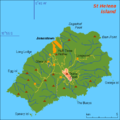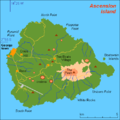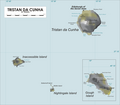St Helena, Ascension and Tristan da Cunha
| St Helena, Ascension and Tristan da Cunha (British overseas territory) | |
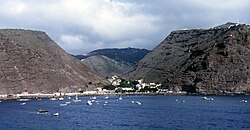 Jamestown, St Helena | |
|---|---|
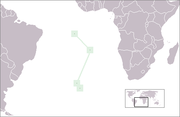
| |

| |
| "Loyal and Unshakeable" | |
| Area: | 162 sq miles |
| Population: | 5,661 (2008) |
| Capital: | Jamestown |
| Time zone: | GMT |
| Dialling code: | 290 and 247 |
| TLD: | .sh & .ac |
St Helena, Ascension and Tristan da Cunha is a British overseas territory in the South Atlantic Ocean consisting of the islands of St Helena, Ascension Island and Tristan da Cunha with its group, islands far apart and dotted along the Mid-Atlantic Ridge. The territory was known as St Helena and Dependencies until 1 September 2009, when a new constitution came into force giving the three islands equal status within the territory.[1]
Islands
Inhabited islands
The inhabited islands are:
| Administrative Area |
Area (sq miles) | Population | Capital |
|---|---|---|---|
| St Helena | 47 | 4,255 | Jamestown |
| Ascension Island | 35 | 1,122 | Georgetown |
| Tristan da Cunha | 80 | 284 | Edinburgh of the Seven Seas |
| Total | 162 | 5,661 | Jamestown |
Uninhabited islands
The territory's uninhabited islands include:
- Boatswain Bird Island (off Ascension at 7°56′09″S 14°18′27″W)
- Gough Island (near Tristan, at 40°19′05″S 9°56′07″W)
- Inaccessible Island (near Tristan, at 37°18′9″ S 12°40′28″ W)
- The Nightingale Islands (near Tristan):
- Middle Island (37°24′40″S 12°28′46″W)
- Nightingale Island (37°25′10″S 12°28′40″W)
- Stoltenhoff Island (37°25′S 12°28′W)
Each of the inhabited islands has its own Council, over which the island's Administrator presides, apart from St Helena where the Governor presides.
History
Geologically each of volcanic origin, the islands of St Helena, Ascension Island, and Tristan da Cunha were all formerly separate colonies of the English crown, though separately discovered by several Portuguese explorers by 1502-1504.
The Portuguese found St. Helena uninhabited, with an abundance of trees and fresh water. They imported livestock, fruit trees and vegetables, and built a chapel and one or two houses. Though they formed no permanent settlement, the island became crucially important for the collection of food and as a rendezvous point for homebound voyages from Asia. Sir Francis Drake very probably located the island on the final lap of his circumnavigation of the world (1577–1580).[2] Further visits by other English explorers followed, and, once St Helena’s location was more widely known, English warships began to lie in wait in the area to attack Portuguese carracks on their way home from India. In developing their Far East trade, the Dutch also began to frequent the island and made a formal claim to it in 1633, but did not settle the isle and by 1651 largely abandoned it in favour of their colony at the Cape of Good Hope.
In 1657, the English East India Company was granted a charter to govern St Helena by Oliver Cromwell,[3] and the following year the Company decided to fortify and colonise the island with planters. The first governor, Captain John Dutton, arrived in 1659, and it is from this date that St Helena claims to be Britain’s second oldest remaining colony (after Bermuda). A fort was completed and a number of houses were built. After the restoration of King Charles II in 1660, the East India Company received a Royal Charter giving it the sole right to fortify and colonise the island. The fort was renamed James Fort and the town Jamestown, in honour of the Duke of York and heir apparent, later King James II.
In subsequent geopolitical developments, all the islands came into British hands. The most important and first settled, the island of St. Helena, had been governed by the East India Company since 1659. It became internationally known as the British Government's chosen place of exile of Napoleon Bonaparte, who was detained on the island from October 1815 until his death on 5 May 1821, and it was made a British crown colony on 28 August 1833. Unoccupied Ascension Island was garrisoned by the Royal Navy on 22 October 1815, shortly after which the end of the Age of Sail made its difficult location in the equatorial doldrums less important relative to its strategic importance as a centrally positioned naval coaling station. For similar reasons Tristan da Cunha was annexed as a dependency of the Cape Colony (British South Africa) on 14 August 1816 at the settlement of the Napoleonic wars.
The political union between these colonies began to take shape on 12 September 1922, when by letters patent Ascension Island became a dependency of St Helena. Lightly populated Tristan da Cunha, even today little more than an outpost with a population of less than three hundred, followed suit on 12 January 1938. The three island groups shared this constitutional relationship until 1 September 2009, when the dependencies were raised to equal status with St. Helena and the territory changed its name from "St Helena and Dependencies" to "St Helena, Ascension and Tristan da Cunha".
During the Second World War, in particular during the Battle of the Atlantic, both St. Helena and Ascension Island were used as bases for patrols against German naval vessels. Initially long range naval patrol flying boats were used in the effort, and later in the war during the struggle to improve air coverage over the commercially important sea lanes, air strips were built to support land based aircraft which supplied, augmented and complemented the PBY Catalina patrol planes in the mission.
The United Kingdom and the United States still jointly operate the airfield on Ascension Island, which also serves as a space-based communications, signals intelligence and navigation nexus and hub (Ground station). One of only five Global Positioning System (GPS) satellite ground stations is located there.
-
Location of St Helena and Ascension Island
-
Map of St Helena
-
Map of Ascension Island
-
Map of Tristan da Cunha group
References
- ↑ http://www.sainthelena.gov.sh/news.php/38/new-constitution St Helena Government information] - the Constitution
- ↑ Drake and St Helena, privately published by Robin Castell in 2005
- ↑ "History: St. Helena homepage". http://www.sthelena.se/history/cron.txt.

